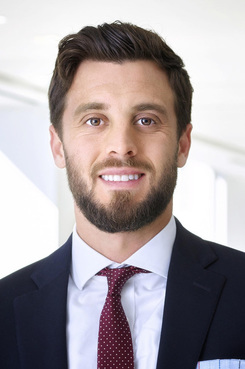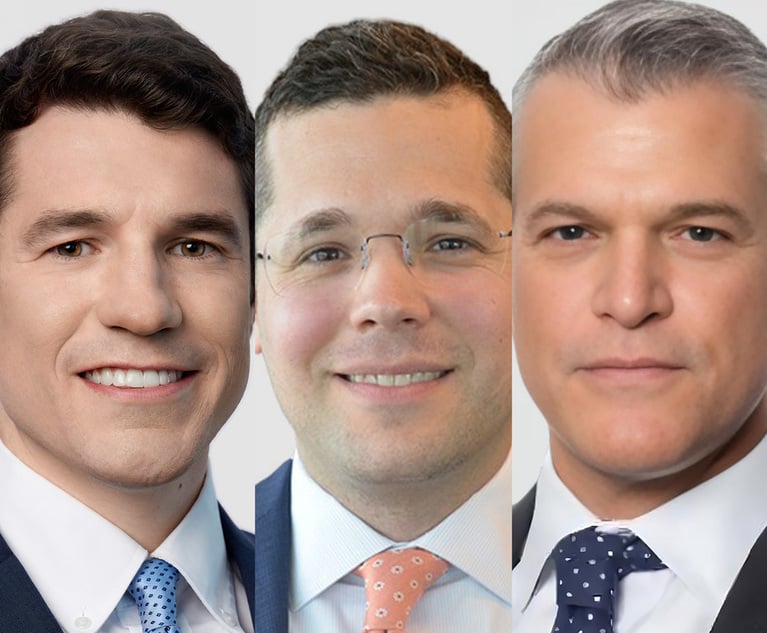Groundbreaking for The Underline Signals New Era of Multimodal Urban Planning
The authors of the Miami Metrorail's environmental impact statement also presciently advised that, “the rapid transit and highway system should complement and facilitate local movements provided by local streets, bicycle paths and pedestrian facilities.
October 26, 2018 at 09:27 AM
5 minute read
 Daniel Balmori, associate with Hogan Lovells in Miami.
Daniel Balmori, associate with Hogan Lovells in Miami.“A well-planned and integrated system becomes as much a part of the urban form as a river or other natural feature and plays a similar role in future development.”
Final environmental impact statements are seldom so poetic, but this was the advice of the U.S. Department of Transportation authors of Project No. FL-03-0036's environmental impact statement when those engineers published their 507-page tome on May 17, 1978, for an ambitious transportation project. This would be the second (and last) of its kind to be constructed in the southeastern United States of America. Project No. FL-03-0036 is now better known as the “Miami Metrorail”—the only rapid transit metro rail system in Florida. It runs for 24.4 miles through some of the heaviest commuter-trafficked portions of the seventh-most populated county in the country.
The authors of the Miami Metrorail's environmental impact statement also presciently advised that, “the rapid transit and highway system should complement and facilitate local movements provided by local streets, bicycle paths and pedestrian facilities … Transportation corridors should be designed for high quality visual experiences,” and that they should, “create a system of interconnected bicycle paths throughout the county” because “linear parks, bikeways and earth berming can create a link between activities on either side.”
To date, those links have been woefully inadequate. Moreover, Miami faces unprecedented transportation challenges that pose grave safety concerns and ultimately limit the region's economic potential. The core mission of one project in particular, however, seeks to ameliorate these deficiencies. That project is The Underline.
Florida is the most dangerous state to walk and bike in the country. Miami-Dade County, specifically, is the 11th most dangerous place to walk in the United States. Conditions continue to grow more perilous each day. The number of bicyclist injuries in Miami-Dade County has more than doubled since 2006. Together, bicyclists and pedestrians account for over one-third of all traffic deaths in Miami-Dade County. Between 2003 and 2013 there were 9,862 total bicycle and pedestrian crashes in Miami-Dade County. Some 1,290 of those bicycle and pedestrian crashes were reported within one mile of the Miami Metrorail south of the Miami River, representing over 13 percent of all countywide bicycle pedestrian accidents.
The Underline is designed to curb, so to speak, these hazards. Master planned by the architects of New York City's renowned High Line, The Underline will transform the land below Miami's Metrorail into a 10 -mile linear park, urban trail and living art destination. The Underline will be Miami-Dade County's first multimodal mobility corridor, allowing users to connect to transit on bike or foot while alleviating traffic. Strategic investment and redesign of 36 key intersections along the 10-mile corridor combined with systematic planning solutions to mediate conflicts between various modes of transportation enhances safety for all.
Further, as detailed by a professional study performed by HR&A Advisors, The Underline will be an economic catalyst for surrounding neighborhoods, creating an estimated $300 to $485 million in incremental value for property owners. Studies of comparable signature linear parks across the country reveal these figures to be conservative. In fact, studies show that by simply providing accessible open space, the value of nearby residential and commercial properties increases 3 to 5 percent with even greater impact occurring on properties directly adjacent to open spaces.
Even 40 forty years after the original transit corridor was planned, we can be proud of our present Board of County Commissioners and mayor as well as a coalition of other municipal servants who—one unanimous vote after another—are embracing thoughtful multimodal transit design. Civic leaders and hard-working local government employees leveraged a paragon of public-private partnerships with a grassroots movement spearheaded by the advocacy nonprofit organization “Friends of The Underline” and its volunteer-in-chief: Meg Daly. Together, they laid the groundwork for The Underline.
To understand where the civic energy for pedestrian and bike paths comes from, one must also understand that projects like The Underline are more than mere transportation infrastructure. The Underline is above all social infrastructure: increasing the quality of life for residents, providing a canvas for public art, activating underutilized public space, re-stitching oft-segregated communities, and providing a free public health amenity for all.
While running through the city recently on a route that takes me through the future Underline, I encountered a message commissioned to be painted on a wall by a Samaritan. The epigram struck me as quite practical—that is, more like a suggestion box tip or Yelp review than a fortune cookie. The message read: “I'll see it when I believe it.”
With Nov. 1's ceremonial groundbreaking for the first half-mile of The Underline, construction is around the corner, and Miami-Dade County can finally begin to enjoy the full multimodal potential promised by this valuable transit corridor since its early planning stages. We have believed it, now we can see it.
Daniel Balmori is an attorney at Hogan Lovells in Miami. He also serves as pro bono counsel to Friends of The Underline, Inc. a 501(c)(3) Florida not-for-profit.
This content has been archived. It is available through our partners, LexisNexis® and Bloomberg Law.
To view this content, please continue to their sites.
Not a Lexis Subscriber?
Subscribe Now
Not a Bloomberg Law Subscriber?
Subscribe Now
NOT FOR REPRINT
© 2025 ALM Global, LLC, All Rights Reserved. Request academic re-use from www.copyright.com. All other uses, submit a request to [email protected]. For more information visit Asset & Logo Licensing.
You Might Like
View All
Initial Steps to Set Up a Fla. Appeal: Your Future Self (or Appellate Attorney) Will Thank You
6 minute read
Divorce Timing Is Everything: Waiting for the New Year May Have Its Advantages
4 minute read
Motions for Summary Judgment and Discovery: The 2021 Rule Changes Continue to Emerge
5 minute read
Trending Stories
Who Got The Work
Michael G. Bongiorno, Andrew Scott Dulberg and Elizabeth E. Driscoll from Wilmer Cutler Pickering Hale and Dorr have stepped in to represent Symbotic Inc., an A.I.-enabled technology platform that focuses on increasing supply chain efficiency, and other defendants in a pending shareholder derivative lawsuit. The case, filed Oct. 2 in Massachusetts District Court by the Brown Law Firm on behalf of Stephen Austen, accuses certain officers and directors of misleading investors in regard to Symbotic's potential for margin growth by failing to disclose that the company was not equipped to timely deploy its systems or manage expenses through project delays. The case, assigned to U.S. District Judge Nathaniel M. Gorton, is 1:24-cv-12522, Austen v. Cohen et al.
Who Got The Work
Edmund Polubinski and Marie Killmond of Davis Polk & Wardwell have entered appearances for data platform software development company MongoDB and other defendants in a pending shareholder derivative lawsuit. The action, filed Oct. 7 in New York Southern District Court by the Brown Law Firm, accuses the company's directors and/or officers of falsely expressing confidence in the company’s restructuring of its sales incentive plan and downplaying the severity of decreases in its upfront commitments. The case is 1:24-cv-07594, Roy v. Ittycheria et al.
Who Got The Work
Amy O. Bruchs and Kurt F. Ellison of Michael Best & Friedrich have entered appearances for Epic Systems Corp. in a pending employment discrimination lawsuit. The suit was filed Sept. 7 in Wisconsin Western District Court by Levine Eisberner LLC and Siri & Glimstad on behalf of a project manager who claims that he was wrongfully terminated after applying for a religious exemption to the defendant's COVID-19 vaccine mandate. The case, assigned to U.S. Magistrate Judge Anita Marie Boor, is 3:24-cv-00630, Secker, Nathan v. Epic Systems Corporation.
Who Got The Work
David X. Sullivan, Thomas J. Finn and Gregory A. Hall from McCarter & English have entered appearances for Sunrun Installation Services in a pending civil rights lawsuit. The complaint was filed Sept. 4 in Connecticut District Court by attorney Robert M. Berke on behalf of former employee George Edward Steins, who was arrested and charged with employing an unregistered home improvement salesperson. The complaint alleges that had Sunrun informed the Connecticut Department of Consumer Protection that the plaintiff's employment had ended in 2017 and that he no longer held Sunrun's home improvement contractor license, he would not have been hit with charges, which were dismissed in May 2024. The case, assigned to U.S. District Judge Jeffrey A. Meyer, is 3:24-cv-01423, Steins v. Sunrun, Inc. et al.
Who Got The Work
Greenberg Traurig shareholder Joshua L. Raskin has entered an appearance for boohoo.com UK Ltd. in a pending patent infringement lawsuit. The suit, filed Sept. 3 in Texas Eastern District Court by Rozier Hardt McDonough on behalf of Alto Dynamics, asserts five patents related to an online shopping platform. The case, assigned to U.S. District Judge Rodney Gilstrap, is 2:24-cv-00719, Alto Dynamics, LLC v. boohoo.com UK Limited.
Featured Firms
Law Offices of Gary Martin Hays & Associates, P.C.
(470) 294-1674
Law Offices of Mark E. Salomone
(857) 444-6468
Smith & Hassler
(713) 739-1250






